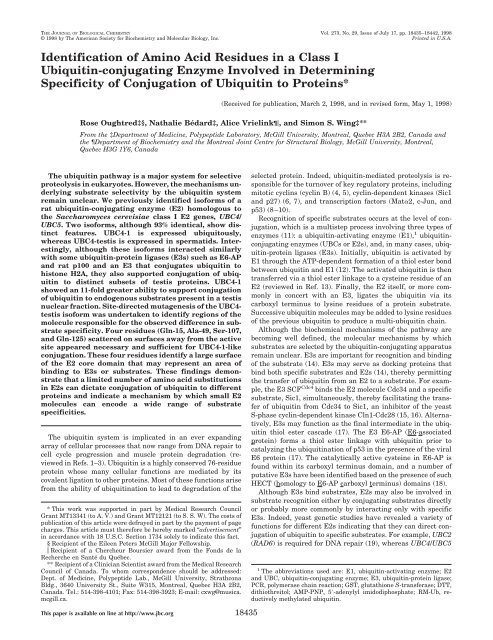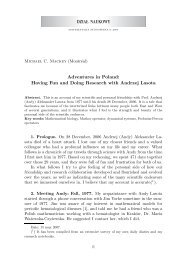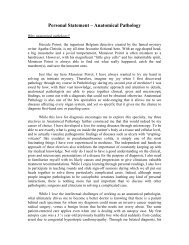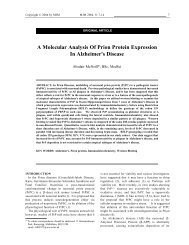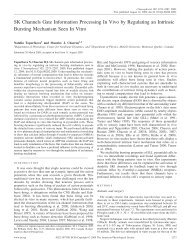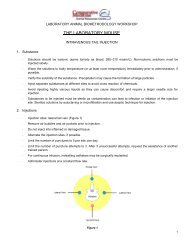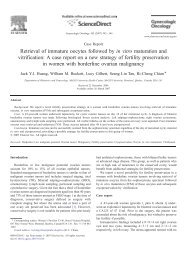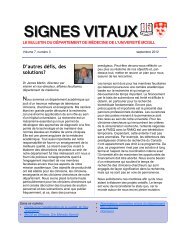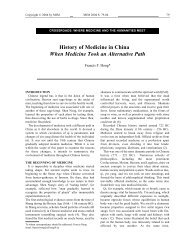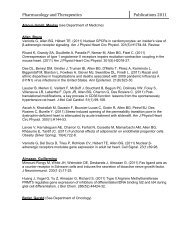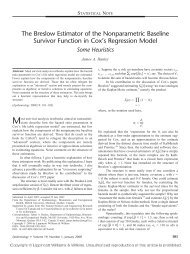Rose. Oughtred, Nathalie. Bedard, Alice. Vrielink ... - McGill University
Rose. Oughtred, Nathalie. Bedard, Alice. Vrielink ... - McGill University
Rose. Oughtred, Nathalie. Bedard, Alice. Vrielink ... - McGill University
Create successful ePaper yourself
Turn your PDF publications into a flip-book with our unique Google optimized e-Paper software.
THE JOURNAL OF BIOLOGICAL CHEMISTRY Vol. 273, No. 29, Issue of July 17, pp. 18435–18442, 1998<br />
© 1998 by The American Society for Biochemistry and Molecular Biology, Inc. Printed in U.S.A.<br />
Identification of Amino Acid Residues in a Class I<br />
Ubiquitin-conjugating Enzyme Involved in Determining<br />
Specificity of Conjugation of Ubiquitin to Proteins*<br />
(Received for publication, March 2, 1998, and in revised form, May 1, 1998)<br />
<strong>Rose</strong> <strong>Oughtred</strong>‡§, <strong>Nathalie</strong> Bédard‡, <strong>Alice</strong> <strong>Vrielink</strong>, and Simon S. Wing‡**<br />
From the ‡Department of Medicine, Polypeptide Laboratory, <strong>McGill</strong> <strong>University</strong>, Montreal, Quebec H3A 2B2, Canada and<br />
the Department of Biochemistry and the Montreal Joint Centre for Structural Biology, <strong>McGill</strong> <strong>University</strong>, Montreal,<br />
Quebec H3G 1Y6, Canada<br />
The ubiquitin pathway is a major system for selective<br />
proteolysis in eukaryotes. However, the mechanisms underlying<br />
substrate selectivity by the ubiquitin system<br />
remain unclear. We previously identified isoforms of a<br />
rat ubiquitin-conjugating enzyme (E2) homologous to<br />
the Saccharomyces cerevisiae class I E2 genes, UBC4/<br />
UBC5. Two isoforms, although 93% identical, show distinct<br />
features. UBC4-1 is expressed ubiquitously,<br />
whereas UBC4-testis is expressed in spermatids. Interestingly,<br />
although these isoforms interacted similarly<br />
with some ubiquitin-protein ligases (E3s) such as E6-AP<br />
and rat p100 and an E3 that conjugates ubiquitin to<br />
histone H2A, they also supported conjugation of ubiquitin<br />
to distinct subsets of testis proteins. UBC4-1<br />
showed an 11-fold greater ability to support conjugation<br />
of ubiquitin to endogenous substrates present in a testis<br />
nuclear fraction. Site-directed mutagenesis of the UBC4testis<br />
isoform was undertaken to identify regions of the<br />
molecule responsible for the observed difference in substrate<br />
specificity. Four residues (Gln-15, Ala-49, Ser-107,<br />
and Gln-125) scattered on surfaces away from the active<br />
site appeared necessary and sufficient for UBC4-1-like<br />
conjugation. These four residues identify a large surface<br />
of the E2 core domain that may represent an area of<br />
binding to E3s or substrates. These findings demonstrate<br />
that a limited number of amino acid substitutions<br />
in E2s can dictate conjugation of ubiquitin to different<br />
proteins and indicate a mechanism by which small E2<br />
molecules can encode a wide range of substrate<br />
specificities.<br />
The ubiquitin system is implicated in an ever expanding<br />
array of cellular processes that now range from DNA repair to<br />
cell cycle progression and muscle protein degradation (reviewed<br />
in Refs. 1–3). Ubiquitin is a highly conserved 76-residue<br />
protein whose many cellular functions are mediated by its<br />
covalent ligation to other proteins. Most of these functions arise<br />
from the ability of ubiquitination to lead to degradation of the<br />
* This work was supported in part by Medical Research Council<br />
Grant MT13341 (to A. V.) and Grant MT12121 (to S. S. W). The costs of<br />
publication of this article were defrayed in part by the payment of page<br />
charges. This article must therefore be hereby marked “advertisement”<br />
in accordance with 18 U.S.C. Section 1734 solely to indicate this fact.<br />
§ Recipient of the Eileen Peters <strong>McGill</strong> Major Fellowship.<br />
Recipient of a Chercheur Boursier award from the Fonds de la<br />
Recherche en Santé du Québec.<br />
** Recipient of a Clinician Scientist award from the Medical Research<br />
Council of Canada. To whom correspondence should be addressed:<br />
Dept. of Medicine, Polypeptide Lab., <strong>McGill</strong> <strong>University</strong>, Strathcona<br />
Bldg., 3640 <strong>University</strong> St., Suite W315, Montreal, Quebec H3A 2B2,<br />
Canada. Tel.: 514-398-4101; Fax: 514-398-3923; E-mail: cxwg@musica.<br />
mcgill.ca.<br />
This paper is available on line at http://www.jbc.org 18435<br />
selected protein. Indeed, ubiquitin-mediated proteolysis is responsible<br />
for the turnover of key regulatory proteins, including<br />
mitotic cyclins (cyclin B) (4, 5), cyclin-dependent kinases (Sic1<br />
and p27) (6, 7), and transcription factors (Mat2, c-Jun, and<br />
p53) (8–10).<br />
Recognition of specific substrates occurs at the level of conjugation,<br />
which is a multistep process involving three types of<br />
enzymes (11): a ubiquitin-activating enzyme (E1), 1 ubiquitinconjugating<br />
enzymes (UBCs or E2s), and, in many cases, ubiquitin-protein<br />
ligases (E3s). Initially, ubiquitin is activated by<br />
E1 through the ATP-dependent formation of a thiol ester bond<br />
between ubiquitin and E1 (12). The activated ubiquitin is then<br />
transferred via a thiol ester linkage to a cysteine residue of an<br />
E2 (reviewed in Ref. 13). Finally, the E2 itself, or more commonly<br />
in concert with an E3, ligates the ubiquitin via its<br />
carboxyl terminus to lysine residues of a protein substrate.<br />
Successive ubiquitin molecules may be added to lysine residues<br />
of the previous ubiquitin to produce a multi-ubiquitin chain.<br />
Although the biochemical mechanisms of the pathway are<br />
becoming well defined, the molecular mechanisms by which<br />
substrates are selected by the ubiquitin-conjugating apparatus<br />
remain unclear. E3s are important for recognition and binding<br />
of the substrate (14). E3s may serve as docking proteins that<br />
bind both specific substrates and E2s (14), thereby permitting<br />
the transfer of ubiquitin from an E2 to a substrate. For example,<br />
the E3 SCF Cdc4 binds the E2 molecule Cdc34 and a specific<br />
substrate, Sic1, simultaneously, thereby facilitating the transfer<br />
of ubiquitin from Cdc34 to Sic1, an inhibitor of the yeast<br />
S-phase cyclin-dependent kinase Cln1-Cdc28 (15, 16). Alternatively,<br />
E3s may function as the final intermediate in the ubiquitin<br />
thiol ester cascade (17). The E3 E6-AP (E6-associated<br />
protein) forms a thiol ester linkage with ubiquitin prior to<br />
catalyzing the ubiquitination of p53 in the presence of the viral<br />
E6 protein (17). The catalytically active cysteine in E6-AP is<br />
found within its carboxyl terminus domain, and a number of<br />
putative E3s have been identified based on the presence of such<br />
HECT (homology to E6-AP carboxyl terminus) domains (18).<br />
Although E3s bind substrates, E2s may also be involved in<br />
substrate recognition either by conjugating substrates directly<br />
or probably more commonly by interacting only with specific<br />
E3s. Indeed, yeast genetic studies have revealed a variety of<br />
functions for different E2s indicating that they can direct conjugation<br />
of ubiquitin to specific substrates. For example, UBC2<br />
(RAD6) is required for DNA repair (19), whereas UBC4/UBC5<br />
1 The abbreviations used are: E1, ubiquitin-activating enzyme; E2<br />
and UBC, ubiquitin-conjugating enzyme; E3, ubiquitin-protein ligase;<br />
PCR, polymerase chain reaction; GST, glutathione S-transferase; DTT,<br />
dithiothreitol; AMP-PNP, 5-adenylyl imidodiphosphate; RM-Ub, reductively<br />
methylated ubiquitin.
18436<br />
FIG. 1. Comparison of rat UBC4-1,<br />
UBC4-testis, and other prototype<br />
class I E2s. Rat isoforms UBC4-1 and<br />
UBC4-testis are homologous to S. cerevisiae<br />
UBC4. The 11 amino acids that differ<br />
between UBC4-1 and UBC4-testis are underlined.<br />
The critical residues that confer<br />
a rat UBC4-1 phenotype on UBC4-testis<br />
are indicated with asterisks. The protein<br />
sequences of the mammalian homologues<br />
of yeast Rad6, HHR6A and HHR6B, and<br />
S. cerevisiae Ubc7 are also depicted. The<br />
active-site cysteine is indicated by an<br />
arrowhead.<br />
are required for the degradation of short-lived and abnormal<br />
proteins (20).<br />
Differences in E2 function evidently reflect differences in E2<br />
structure. E2 enzymes have been divided into four structural<br />
classes based on amino acid sequence comparison (21). Class I<br />
enzymes (e.g. Ubc4 and Ubc5) (20) consist of a conserved catalytic<br />
core domain of 150 amino acids that contains the activesite<br />
cysteine involved in ubiquitin transfer. Class II enzymes<br />
(e.g. Ubc2/Rad6 and Ubc3/Cdc34) (19, 22) have extra C-terminal<br />
extensions or tails attached to the core domain, whereas<br />
class III enzymes (e.g. UbcH6 and UbcD2) (23, 24) have attached<br />
N-terminal tails. Finally, class IV enzymes (e.g. E2-C)<br />
(25) possess both C- and N-terminal extensions.<br />
Jentsch et al. (21) speculated that E2 extensions play either<br />
a direct role in substrate recognition or else an indirect role<br />
through their interaction with E3s. While C- and N-terminal<br />
extensions may participate in specifying the interaction of E2s<br />
with E3s and/or substrates, a number of studies have indicated<br />
that specificity elements also reside within the E2 core. For<br />
example, the class II enzyme RAD6 is required for DNA repair,<br />
induced mutagenesis, and sporulation in yeast (19) and is<br />
capable of polyubiquitinating histones in vitro (26). However,<br />
removal of the polyacidic tail of Rad6 results only in loss of its<br />
sporulation function (27) and histone-polyubiquitinating activity<br />
(26). The core domain is sufficient for performing its DNA<br />
repair function. Since this truncated Rad6 containing only the<br />
core domain exhibits a distinct phenotype from the class I (core<br />
domain only) E2s, Ubc4 and Ubc5, which function in the turnover<br />
of short-lived and abnormal proteins (20), the core domain<br />
must possess determinants of function and by inference substrate<br />
specificity. More recently, the C-terminal tail of E2–25K<br />
was found to be necessary, but not sufficient, for some of its E2<br />
functions, indicating that the tail depends on structural features<br />
in the core for its function (28). These and other results<br />
suggest that although E2 core domains are highly conserved,<br />
they possess unique structural features that are critical for<br />
individual E2 function and specificity.<br />
Recently, we cloned and characterized a family of mammalian<br />
class I E2s homologous to S. cerevisiae Ubc4/Ubc5 (29, 30).<br />
E2 Residues Determining Substrate Specificity<br />
Two isoforms of rat UBC4, 2 although 93% identical, show distinct<br />
features. Rat UBC4-testis possesses an acidic pI and<br />
shows testis-specific RNA expression that is specifically induced<br />
in the developing spermatids (30), whereas rat UBC4-1<br />
has a basic pI and is expressed ubiquitously (29). Therefore,<br />
although the high degree of sequence similarity might suggest<br />
that these isoforms are redundant, the highly regulated and<br />
cell-specific expression suggested a unique role for the UBC4testis<br />
isoform.<br />
Therefore, we characterized carefully the abilities of rat<br />
UBC4-1 and UBC4-testis to support conjugation of ubiquitin in<br />
vitro to different subsets of testis proteins. Rat UBC4-1 shows<br />
an 11-fold greater ability to support conjugation of ubiquitin to<br />
endogenous substrates present in a testis nuclear fraction (30).<br />
We also determined whether these two isoforms interact differentially<br />
with other E3s. In addition, since rat UBC4-1 and<br />
UBC4-testis differ by only 11 amino acids (Fig. 1) and they are<br />
highly similar to yeast Ubc4, whose crystal structure has been<br />
solved (31), this provided a unique opportunity to identify, by<br />
site-directed mutagenesis of UBC4-testis, regions of the E2<br />
core domain responsible for the observed difference in substrate<br />
specificity.<br />
EXPERIMENTAL PROCEDURES<br />
Site-directed Mutagenesis—pET-11d (Novagen)-based Escherichia<br />
coli expression plasmids encoding rat UBC4-1 or UBC4-testis have<br />
been described (29, 30). Mutagenesis of selected residues in UBC4testis<br />
to those in UBC4-1 was performed using the Chameleon doublestranded<br />
site-directed mutagenesis kit (Stratagene) according to the<br />
manufacturer’s instructions. Briefly, separate mutagenic primers3 encoding<br />
site-specific mutations in UBC4-testis and a selection primer<br />
were annealed to denatured UBC4-testis-containing pET-11d plasmids,<br />
2 Previously, the rat homologue of yeast Ubc4 was referred to as<br />
E217KB and included isoforms 2E and 8A (29, 30). For purposes of clarity<br />
and to conform to a trend by workers in the field to name E2s after their<br />
apparent yeast homologues, isoform 2E will henceforth be referred to as<br />
rat UBC4-1, and isoform 8A as rat UBC4-testis. The nucleotide sequences<br />
of UBC4-1 and UBC4-testis have been submitted to Gen-<br />
BankTM with accession numbers U13177 and U56407.<br />
3 Oligonucleotide sequences and detailed PCR conditions are available<br />
on request.
and the mutant DNA strand was extended with T7 DNA polymerase<br />
and ligated with T4 DNA ligase. The selection primer, located 2<br />
kilobases from the mutagenic primers, changed the unique AccI restriction<br />
site on pET-11d to a unique KpnI restriction site on the mutant<br />
plasmid strand, thereby permitting selection of intact mutant plasmids<br />
by digestion with AccI. Initially, separate mutant UBC4-testis constructs<br />
with a D55H, E68A, or double D55H/E68A substitution were<br />
generated. Similarly, subsequent mutations were added separately or<br />
in combination onto the initial UBC4-testis D55H/E68A double mutant<br />
in the following order: Gln-15, Gln-125, Ala-49, or Ser-107. The intact<br />
mutant plasmids were transformed into E. coli XL1-Blue cells (Stratagene).<br />
All plasmids were sequenced to confirm the presence of the<br />
desired mutation using the fmol TM DNA sequencing System (Promega).<br />
Subtractive mutagenesis was then performed in a similar manner to<br />
define the minimal UBC4-1 residues on UBC4-testis that were necessary<br />
and sufficient for the UBC4-1-like conjugating activity.<br />
The converse mutagenesis of the four critical residues (Arg-15, Val-<br />
49, Cys-107, and Arg-125) of UBC4-1 to those of UBC4-testis was<br />
performed via PCR amplification (32). Mutant UBC4-1 fragments were<br />
generated using UBC4-1-containing pET-11d as a template, primers<br />
bearing the relevant base substitutions, and sense or antisense oligonucleotides<br />
encoding the amino and carboxyl termini of the protein as<br />
well as restriction sites to permit cloning into the NcoI and BamHI sites<br />
of pET-11d. The mutant UBC4-1 fragments were then purified by<br />
agarose gel electrophoresis and incorporated into full-length mutant<br />
UBC4-1 inserts via a second round of PCR amplification using the<br />
separate mutant UBC4-1 fragments as a template and both the 5-NcoI<br />
and the 3-BamHI primers. The PCR products were purified on a<br />
QIAquick PCR purification column (QIAGEN Inc.), digested with NcoI<br />
and BamHI, and then ligated into a pET-11d vector that had been<br />
digested with the same enzymes. Purified plasmids were transformed<br />
into XL1-Blue cells, and individual positive clones were sequenced<br />
using the fmol TM DNA sequencing system to confirm the presence of the<br />
desired mutation.<br />
Preparation of Proteins—The pGEX-ubiquitin plasmid encoding the<br />
GST-ubiquitin fusion protein (33) was expressed in E. coli strain DH5<br />
and induced with 0.1 mM isopropyl--D-thiogalactopyranoside for 2hat<br />
37 °C. Bacterial cell pellets resuspended in phosphate-buffered saline<br />
and 1% Triton X-100 were lysed by sonication and clarified by centrifugation<br />
at 12,000 g. Glutathione-Sepharose (Amersham Pharmacia<br />
Biotech) was added to the supernatant, and the mixture was rotated<br />
overnight at 4 °C. Beads were washed in phosphate-buffered saline and<br />
1% Triton X-100 and eluted in 20 mM glutathione in phosphate-buffered<br />
saline for 20 min at 25 °C. The GST-ubiquitin fusion protein content<br />
was estimated to be 1 mg/ml by Coomassie Blue staining.<br />
E1 was prepared from rabbit liver. Bacterially expressed recombinant<br />
UBC4-1 and UBC4-testis proteins were also purified as described<br />
previously (29, 30). The E1, UBC4-1, and UBC4-testis enzymes were<br />
quantified by measuring the initial release of radioactive pyrophosphate<br />
following incubation in the presence of [- 32 P]ATP and ubiquitin<br />
(34).<br />
The purified pET-11d-based plasmids containing the mutant<br />
UBC4-1 and UBC4-testis genes were transformed into E. coli BL21<br />
(DE3) (Novagen), and induction of the recombinant proteins with 1 mM<br />
isopropyl--D-thiogalactopyranoside was carried out for 2hat30°C.<br />
The cells were pelleted and resuspended in 0.1 volume and then lysed<br />
by sonication in 50 mM Tris, pH 7.5, and 1 mM DTT. Cellular debris was<br />
removed by centrifugation at 12,000 g. The enzymatic activities of the<br />
mutant E2-containing bacterial lysates relative to the purified recombinant<br />
UBC4-1 and UBC4-testis enzymes were determined by thiol<br />
ester assays, as described below.<br />
The [ 35 S]methionine-labeled E6-AP (35) or rat p100 (36) proteins<br />
were synthesized separately in vitro using a coupled transcription/<br />
translation kit (wheat germ extract TNT, Promega) with T7 polymerase.<br />
The translation reactions (150 l) were partially purified with<br />
DEAE-cellulose resin (Whatman DE52; 200 mg of wet resin/TNT reaction)<br />
using a batch elution procedure to remove ubiquitin, E1, and E2s<br />
homologous to rat UBC4 that were present in the break-though fraction.<br />
Briefly, the translation reactions and resin were incubated in 4.5<br />
ml of loading buffer (50 mM Tris-HCl, pH 7.5, and 1 mM DTT) for 1hat<br />
4 °C, washed two times, and eluted in loading buffer containing 0.5 M<br />
NaCl. The E3-containing eluates (2 ml) were then concentrated 10-fold<br />
by ultrafiltration with Centricon-30 concentrators (Amicon, Inc.), and 2<br />
l of each E3 preparation were utilized in each thiol ester assay.<br />
The testis cytosolic E3 and nuclear fractions eluting from a MonoQ<br />
anion-exchange column (Amersham Pharmacia Biotech) at 0.4 and 0.05<br />
M NaCl, respectively, were isolated as described previously (30). In<br />
some preparations, the nuclear fraction activity was found in the flow-<br />
E2 Residues Determining Substrate Specificity 18437<br />
through fraction instead of eluting at 0.05 M NaCl; however, it behaved<br />
identically to the original preparation eluting at 0.05 M NaCl. This<br />
nuclear fraction was concentrated 4-fold using a Centricon-10 concentrator<br />
(Amicon, Inc.). The testis cytosolic E3 activity was further purified<br />
by chromatography on a Superdex 200 gel filtration column (Amersham<br />
Pharmacia Inc.).<br />
Iodination of Proteins—The chloramine-T method was used to label<br />
bovine ubiquitin with Na 125 I to a specific radioactivity of 3000 cpm/<br />
pmol (37) and histone H2A (Boehringer Mannheim) to a specific radioactivity<br />
of 375,000 cpm/g. Unincorporated 125 I was removed by passing<br />
the reaction products over a Sephadex G-25 column.<br />
Thiol Ester Assays—The relative enzymatic activities of the purified<br />
recombinant rat UBC4-1 and UBC4-testis proteins and of the mutant<br />
E2-containing bacterial lysates were determined by incubating the<br />
following in a total volume of 10 l: 50 mM Tris-HCl, pH 7.5, 1 mM DTT,<br />
2mM MgCl 2,2mM ATP, 100 nM E1, 20 units/ml inorganic pyrophosphatase,<br />
5 M 125 I-ubiquitin (3000 cpm/pmol), and 2.5 pmol of the<br />
purified E2s (5 pmol/l) or various amounts of the mutant E2 lysates.<br />
After incubation at 37 °C for 1 min, the reaction was stopped with<br />
Laemmli sample buffer without -mercaptoethanol and resolved by<br />
12.5% SDS-polyacrylamide gel electrophoresis at 4 °C followed by autoradiography.<br />
The thiol ester bands were excised from the gels to<br />
measure the incorporated radioactivity and thereby estimate the mutant<br />
E2 enzymatic activities relative to those of the purified native E2s<br />
(5 pmol/l). Assaying dilutions of the E2-containing extracts confirmed<br />
linearity of the assays.<br />
The [ 35 S]methionine-labeled E3s E6-AP (35) and rat p100 (36), covalently<br />
bound to GST-ubiquitin fusion protein in thiol ester linkages<br />
(17, 18), were detected by incubating the enzymes in the presence of 50<br />
mM Tris-HCl, pH 7.5, 1 mM DTT, 2 mM MgCl 2,2mM ATP, 50 nM E1, 20<br />
units/ml inorganic pyrophosphatase, 500 nM E2, and 2 l of each partially<br />
purified and concentrated E3 preparation. The reaction mixtures<br />
were preincubated at 25 °C for 3 min, and then the reaction was<br />
initiated with 1 g of GST-ubiquitin fusion protein (33), incubated at<br />
25 °C for 5 min, and stopped with Laemmli sample buffer with or<br />
without -mercaptoethanol. The reactions were resolved at 4 °C on an<br />
SDS-12.5% polyacrylamide gel, which was then soaked in ENHANCE<br />
(NEN Life Science Products) and autoradiographed.<br />
Conjugation Assays—For the conjugation of ubiquitin to endogenous<br />
substrates present in the testis nuclear fraction, the reaction mixture<br />
contained the following in a final volume of 20 l: 10 l of the 0.05 M<br />
NaCl nuclear fraction, 50 mM Tris-HCl, pH 7.5, 1 mM DTT, 2 mM MgCl 2,<br />
2mM AMP-PNP, 5 M 125 I-ubiquitin (3000 cpm/pmol), 50 nM E1, and<br />
250 nM E2s. The ubiquitination rate for the nuclear fraction was linear<br />
for 1 h at 37 °C, and this assay was performed in the presence or<br />
absence of 0.5 g of ubiquitin aldehyde, an isopeptidase inhibitor, or 40<br />
M MG132 (Proscript), a proteasome inhibitor.<br />
For the conjugation of ubiquitin to the exogenous substrate histone<br />
H2A, mediated by the testis cytosolic E3, the reaction mixture contained<br />
the following in a final volume of 20 l: 3 l of the cytosolic E3<br />
Superdex 200 fraction, 50 mM Tris-HCl, pH 7.5, 1 mM DTT, 2 mM MgCl 2,<br />
2mM ATP, 0.5 units pyrophosphatase, 12.5 mM phosphocreatine, 2.5<br />
units of creatine kinase, 250 nM E1, 125 I-histone H2A (specific activity<br />
of 375,000 cpm/g), and varied concentrations of E2 as indicated. Reactions<br />
were initiated with 25 M reductively methylated ubiquitin<br />
(RM-Ub), prepared, and quantified as described (38). Since histone H2A<br />
contains a number of lysine residues, mono- to penta-RM-Ub conjugates<br />
were formed, and the rate of formation of these conjugates was found to<br />
be linear for 10 min at 30 °C, permitting their quantification.<br />
RESULTS<br />
Differential Abilities of Rat UBC4-1 and UBC4-testis to Conjugate<br />
Ubiquitin to a Fraction of Testis Nuclear Proteins—To<br />
test whether the structural differences between rat UBC4-1<br />
and UBC4-testis conferred different abilities to conjugate ubiquitin<br />
to proteins, ubiquitination assays were performed using<br />
testis extracts fractionated on a MonoQ anion-exchange column.<br />
As shown previously (30), a nuclear fraction eluting at<br />
0.05 M NaCl supported conjugation of ubiquitin to proteins<br />
essentially only with the UBC4-1 isoform (Fig. 2A). This indicated<br />
that these two isoforms showed differential substrate<br />
specificity and suggested an enhanced ability of the ubiquitous<br />
isoform to conjugate ubiquitin to endogenous proteins in this<br />
fraction. To evaluate the possibility that UBC4-testis was conjugating<br />
ubiquitin to proteins that are preferentially de-ubiq-
18438<br />
FIG. 2.Differential abilities of UBC4-1 and UBC4-testis to conjugate<br />
ubiquitin to a fraction of testis nuclear proteins. A, a<br />
nuclear testis extract was chromatographed on a MonoQ anion-exchange<br />
column. The fraction eluting at 0.05 M NaCl was incubated with<br />
E1, AMP-PNP, and 125 I-ubiquitin in the presence or absence (E2) of<br />
rat UBC4-1 (4-1) or UBC4-testis (4-T)for1hat37°C.Similar reactions<br />
were also performed in the presence of ubiquitin aldehyde (Ub Ald), an<br />
isopeptidase inhibitor, or MG132, a proteasome inhibitor. Ubiquitinated<br />
endogenous substrates were then analyzed by SDS-polyacrylamide<br />
gel electrophoresis and autoradiography. The high molecular<br />
mass ubiquitin-substrate conjugates remain within the stacking gel<br />
during electrophoresis. B, the preparations of UBC4-1 and UBC4-testis<br />
(5 pmol/l each) used in A were tested for their abilities to form thiol<br />
esters with 125 I -ubiquitin in the presence of E1 and ATP. Ub, ubiquitin.<br />
uitinated by a co-purifying isopeptidase activity, the conjugation<br />
assay was performed in the presence of the isopeptidase<br />
inhibitor ubiquitin aldehyde. Notably, the level of UBC4-testisdependent<br />
conjugation was not increased by the addition of this<br />
reagent, rendering unlikely the possibility of a co-purifying<br />
interfering isopeptidase. Likewise, to rule out the possibility of<br />
enhanced proteasomal degradation of the UBC4-testis-dependent<br />
conjugates, the conjugation assay was performed in the<br />
presence of the proteasomal inhibitor MG132. Similarly,<br />
MG132 did not increase the levels of UBC4-testis-dependent<br />
conjugates.<br />
Significantly, the observed difference in conjugating ability<br />
between UBC4-1 and UBC4-testis was not due to a difference<br />
in the ability of these E2s to accept ubiquitin from E1 because<br />
UBC4-1 and UBC4-testis formed similar amounts of ubiquitin<br />
thiol esters (Fig. 2B). These thiol ester assays are end-point<br />
assays, and the results cannot exclude the possibility of different<br />
affinities of these two isoforms for E1. However, more<br />
detailed thiol ester-based enzyme kinetic studies suggest that<br />
UBC4-1 and UBC4-testis show less than a 2-fold difference in<br />
their affinities for E1 (data not shown).<br />
Rat Isoforms UBC4-1 and UBC4-testis Interact with the E3s<br />
E6-AP and Rat p100—Since the observed difference in conjugation<br />
by rat UBC4-1 and UBC4-testis was found not to be due<br />
to significant differences in their interaction with E1, this<br />
suggested that the specificity might arise at the E2-E3 level.<br />
We therefore tested the abilities of rat UBC4-1 and UBC4testis<br />
to interact with some well defined E3s, E6-AP (10, 17)<br />
and rat p100 (18), which contain HECT domains and thereby<br />
form thiol ester linkages with ubiquitin by accepting ubiquitin<br />
from E2 thiol esters. We tested the abilities of rat UBC4-1 and<br />
UBC4-testis to transfer ubiquitin to E6-AP and rat p100 produced<br />
by in vitro translation (Fig. 3). Since these E3s are<br />
relatively large, a GST-ubiquitin fusion protein (molecular<br />
mass of 34 kDa) (18) was used to permit resolution of the<br />
E3-ubiquitin thiol ester linkage by gel electrophoresis. In the<br />
presence of E1, GST-ubiquitin, and rat UBC4-1 or UBC4-testis,<br />
bands 34 kDa larger than the expected translation products<br />
were evident. These bands were not present when the thiol<br />
ester reactions were treated with -mercaptoethanol or when<br />
the reaction was performed in the absence of rat UBC4-1 and<br />
UBC4-testis. Again, these results obtained with thiol ester<br />
E2 Residues Determining Substrate Specificity<br />
FIG. 3.UBC4-1 and UBC4-testis transfer ubiquitin similarly to<br />
the E3s E6-AP and rat p100. The rat p100 cDNA and human E6-AP<br />
cDNA were transcribed and translated in vitro using wheat germ extract.<br />
The 35 S-labeled translation products were partially purified over<br />
a DE52 column to remove endogenous E2s homologous to UBC4/UBC5.<br />
Thiol ester assays were then performed with the E3s using rat UBC4-1<br />
(4-1) or UBC4-testis (4-T) and a GST-ubiquitin fusion protein (GST-<br />
Ub). Reactions were quenched with SDS-polyacrylamide gel electrophoresis<br />
sample buffer without or with -mercaptoethanol (2-Me). After<br />
electrophoresis, the E3-ubiquitin thiol ester adducts (indicated by arrows)<br />
were detected by autoradiography.<br />
assays do not eliminate the possibility that these E2 isoforms<br />
could differ somewhat in their affinities for these E3s. More<br />
detailed kinetic assays are not feasible in these crude preparations<br />
from in vitro translation, where the concentrations of the<br />
E3s cannot be readily determined. Nonetheless, the results<br />
demonstrated that these two isoforms are both capable of interacting<br />
with ubiquitin-protein ligases as shown by their ability<br />
to transfer ubiquitin to at least two different E3s, E6-AP<br />
and rat p100.<br />
Rat Isoforms UBC4-1 and UBC4-testis Support Ubiquitination<br />
of Histone H2A Mediated by a Testis Cytosolic E3—Since<br />
the assays described above do not permit ready quantitative<br />
determinations of reaction rates, we tested both isoforms for<br />
their ability to support conjugation of ubiquitin to an exogenous<br />
substrate, histone H2A, mediated by a testis E3. To this<br />
end, a testis cytosolic E3 activity (29, 30) eluting at 0.4 M NaCl<br />
from a MonoQ anion-exchange column was further fractionated<br />
using a gel filtration column. This E3 activity was found to<br />
support conjugation of ubiquitin to the exogenous substrate<br />
125 I-labeled histone H2A in the presence of rat UBC4-1 and<br />
UBC4-testis. The effectiveness of these two isoforms in supporting<br />
this E3-dependent ubiquitination of 125 I-histone H2A<br />
was compared using E1, an ATP-regenerating system, RM-Ub<br />
(38), and different concentrations of rat UBC4-1 and UBC4testis<br />
(Fig. 4A). RM-Ub was utilized in the assays to restrict the<br />
ubiquitination of histone H2A to the mono-ubiquitinated form,<br />
which would facilitate the quantification of conjugates. Multiubiquitinated<br />
forms of histone H2A were observed, indicating<br />
that ubiquitin is attached to several different lysine residues of<br />
the molecule. In contrast to the differential ubiquitin-conjugating<br />
abilities of rat UBC4-1 and UBC4-testis observed in the
FIG. 4.UBC4-1 and UBC4-testis support conjugation of ubiquitin<br />
to histone H2A mediated by a testis cytosolic E3. A, the<br />
effectiveness of UBC4-1 or UBC4-testis in supporting E3-dependent<br />
ubiquitination of 125 I-histone H2A was compared using E1, an ATPregenerating<br />
system, RM-Ub, and different concentrations of rat<br />
UBC4-1 or UBC4-testis, incubated for 10 min at 30 °C. After electrophoresis,<br />
the RM-Ub- 125 I-histone H2A conjugates were detected by<br />
autoradiography. B, the differential conjugating abilities of rat UBC4-1<br />
and UBC4-testis observed in the nuclear fraction are not due to a<br />
UBC4-testis-specific inhibitor in the 0.05 M NaCl nuclear fraction. The<br />
above conjugation assay with UBC4-testis was performed in the presence<br />
or absence of the indicated amounts of the testis nuclear fraction<br />
eluting at 0.05 M NaCl from a MonoQ column.<br />
testis nuclear fraction, both isoforms support conjugation of<br />
ubiquitin to histone H2A mediated by the testis cytosolic E3 to<br />
similar extents. Thus, the preferential conjugating activity of<br />
UBC4-1 as compared with UBC4-testis observed in the nuclear<br />
fraction demonstrates that such specificity appears to be selective<br />
for specific E3s or substrates.<br />
To ascertain that the differential conjugating ability of rat<br />
UBC4-1 and UBC4-testis observed in the testis nuclear fraction<br />
was not due to an inhibitor of the UBC4-testis activity<br />
present in this fraction, the histone conjugation assay was<br />
performed in the presence or absence of the nuclear fraction<br />
(Fig. 4B). UBC4-testis supported E3-mediated conjugation of<br />
ubiquitin to 125 I-histone H2A to similar levels with or without<br />
E2 Residues Determining Substrate Specificity 18439<br />
the nuclear fraction. Thus, these data, in conjunction with the<br />
absence of effects of ubiquitin aldehyde and MG132, are consistent<br />
with the differential conjugating abilities of rat UBC4-1<br />
and UBC4-testis in the nuclear fraction being attributable to<br />
differences in their interactions with specific, and as yet unidentified,<br />
E3s or substrates.<br />
Four Amino Acid Differences Are Responsible for the Abilities<br />
of Rat Isoforms UBC4-1 and UBC4-testis to Conjugate Ubiquitin<br />
to Different Subsets of Testis Nuclear Proteins—Since the<br />
rat UBC4-1 and UBC4-testis isoforms differ by only 11 amino<br />
acids (Fig. 1) (30), this provided an unprecedented opportunity<br />
to identify, by site-directed mutagenesis, critical residues of the<br />
E2 molecule responsible for the observed difference in substrate<br />
specificity. Site-directed mutagenesis of the UBC4-testis<br />
isoform was undertaken to identify regions of the molecule that<br />
can confer the UBC4-1-like ability to conjugate ubiquitin to the<br />
endogenous substrates present in the nuclear fraction.<br />
Since rat UBC4-1 and UBC4-testis differ with respect to<br />
their pI values (30), mutagenesis of UBC4-testis began with the<br />
four residues responsible for the dramatic change in pI. Of<br />
particular interest were the two residues, aspartic acid 55 and<br />
glutamic acid 68, located near the active-site cysteine, that<br />
were mutated to histidine and alanine, respectively. However,<br />
mutation of UBC4-testis to the UBC4-1 residues at these two<br />
sites did not confer UBC4-1-like ability to conjugate 125 I-ubiquitin<br />
to the substrates present in the testis nuclear fraction<br />
(Fig. 5A). Additional mutagenesis of glutamines 15 and 125,<br />
the two other residues responsible for the change in pI, to<br />
arginines resulted in a small increase in conjugating activity of<br />
the mutated UBC4-testis. Since mutagenesis of the two glutamine<br />
residues appeared to increase the conjugating activity of<br />
the mutated UBC4-testis, further residues nearby were mutated.<br />
Mutation of alanine 49 to valine conferred some increase<br />
in activity, and an additional mutation of serine 107 to cysteine<br />
conferred a UBC4-1 phenotype in conjugating ability to the<br />
mutated UBC4-testis.<br />
To determine the minimal number of substitutions required<br />
for the UBC4-1-like conjugating activity of the mutated UBC4testis,<br />
subtractive mutagenesis was then performed. Since mutagenesis<br />
of Gln-15, Ala-49, Ser-107, and Gln-125 improved<br />
conjugating activity, these four mutations were tested together<br />
and found to be sufficient (Fig. 5A). Further removal of any one<br />
of these substitutions decreased conjugating ability significantly,<br />
and therefore, these four substitutions are necessary<br />
(Fig. 5B).<br />
Our observation that these residues are important would<br />
predict that mutating the rat UBC4-1 molecule at these positions<br />
to the UBC4-testis residues would decrease the conjugating<br />
activity of UBC4-1. To test this prediction, mutagenesis of<br />
UBC4-1 to UBC4-testis was performed at these four residues.<br />
As expected, mutagenesis of each of the critical residues (Arg-<br />
15, Val-49, Cys-107, or Arg-125) resulted in decreased conjugating<br />
activity of rat UBC4-1 in the testis nuclear fraction (Fig.<br />
6, A and B). Interestingly, the four residues in UBC4-testis,<br />
which were found to be necessary and sufficient for the UBC4-<br />
1-like conjugating activity, are present on surfaces away from<br />
the active site (Fig. 7) (31).<br />
DISCUSSION<br />
We have, for the first time, identified, in the core domain<br />
conserved among all ubiquitin-conjugating enzymes, specific<br />
sites that are involved in determining substrate specificity of<br />
conjugation. These studies revealed a number of intriguing<br />
insights. First, although we anticipated, based on the 93%<br />
amino acid identity between the two isoforms, that only a<br />
limited number of residues in the core domain of E2s may<br />
dictate conjugation of ubiquitin to different proteins, surpris-
18440<br />
FIG. 5. Only four residues are necessary<br />
and sufficient to confer a rat<br />
UBC4-1 phenotype on UBC4-testis. A,<br />
bacterially expressed mutant UBC4-testis<br />
proteins were tested for their ability to<br />
support conjugation with the 0.05 M NaCl<br />
testis nuclear fraction in assays as described<br />
in the legend to Fig. 2. B, the<br />
minimal number of substitutions required<br />
for UBC4-1-like conjugating activity<br />
in the testis nuclear fraction was determined.<br />
Removal of some of these<br />
substitutions appeared to decrease conjugating<br />
ability, and therefore, these four<br />
substitutions appear necessary. C, the<br />
conjugating activities of the UBC4-testis<br />
mutants relative to the UBC4-1 isoform<br />
were compared by counting the radioactivity<br />
in the gel lanes (S.E.) and were<br />
normalized to the value for UBC4-1. D,<br />
Asp-55; E, Glu-68; Q1, Gln-15; Q2, Gln-<br />
125; A, Ala-49; S, Ser-107.<br />
ingly only four substitutions (Figs. 5 and 6) were sufficient and<br />
necessary to produce the change in substrate specificity.<br />
Second, some of these substitutions were physiochemically<br />
relatively conserved, indicating that subtle changes in primary<br />
structure can be important in determining selectivity of substrates.<br />
One involved an Ala to Val conversion, whereas the<br />
other involved a Cys for Ser substitution. The other two substitutions,<br />
on the other hand, were nonconserved. The polar<br />
uncharged Gln residues in UBC4-testis have been mutated to<br />
the polar basic Arg residue. Thus, part of the interaction of<br />
UBC4-1 and a testis nuclear substrate or E3 could be due to<br />
electrostatic interactions between the molecules. However, differences<br />
in electrostatic attractions alone are unlikely to account<br />
for the specificity observed here because all four residues,<br />
including the two conserved substitutions, are necessary for<br />
conferring a UBC4-1-like phenotype on UBC4-testis. Since all<br />
four residues are on the surface, their substitution is unlikely<br />
to induce a significant conformational change on the E2 molecule.<br />
Instead, it may be that all four of these critical residues<br />
result in a surface configuration that functions to lower the free<br />
energy of binding of UBC4-1 to an E3 or substrate, thereby<br />
facilitating the UBC4-1-dependent conjugation of ubiquitin to<br />
specific proteins in the testis nuclear fraction.<br />
Third, the four critical residues in UBC4-1 are not localized,<br />
but spread over a broad surface of the E2 molecule away from<br />
the active site (Fig. 7), and so a large surface of the E2 core may<br />
be involved in binding an E3 or substrate. The critical residues<br />
are localized as follows: the N-terminal Gln-15 is in the stretch<br />
between the first -helix and the first -strand; the N-terminal<br />
Ala-49 is in the third -strand; the C-terminal Ser-107 is in the<br />
second -helix; and finally, the N-terminal Gln-125 is in the<br />
third -helix.<br />
E2 Residues Determining Substrate Specificity<br />
Although all E2s exhibit limited sequence identity and are<br />
functionally different, the overall three-dimensional folding of<br />
E2 core domains that have been crystallized to date is remarkably<br />
similar (31, 40–42). The 150 amino acids of the E2 core<br />
domains show 25% sequence identity, and notably, most of<br />
the identical residues are either buried or clustered on one<br />
surface adjacent to the active-site cysteine (31). It has been<br />
suggested that the highly conserved surface region around the<br />
active site may be specific for ubiquitin and/or E1 binding,<br />
whereas the divergent surface regions may enable individual<br />
E2 enzymes to bind their respective substrates or E3s (31). Our<br />
data now provide experimental evidence to support this<br />
hypothesis.<br />
Although we have not to date been able to identify an exogenous<br />
substrate that requires the nuclear fraction for conjugation,<br />
other studies (30, 43) showing that this family of E2s<br />
interacts extensively with E3s would suggest that the nuclear<br />
fraction probably does contain an E3 activity. Recent findings<br />
suggest that a putative E2-binding site exists in the C terminus<br />
of HECT domain-containing E3s and that a variable E3 N<br />
terminus may be involved in binding substrates (44). Since the<br />
residues found to be critical for the UBC4-1-like conjugating<br />
activity lie on a surface away from the active site, this surface<br />
may be responsible for the selective interaction of UBC4-1 with<br />
a nuclear E3. This could permit the small E2 molecule, while<br />
bound to the larger E3 protein (known E3s are 95 kDa in<br />
size), to expose its active-site cysteine, thereby facilitating the<br />
transfer of ubiquitin to the E3 if it contains a HECT domain or<br />
directly to a substrate if the E3 is functioning primarily as a<br />
docking protein (Fig. 8).<br />
Fourth, it is possible that some E2s can functionally overlap<br />
with some E3s or substrates, yet be selective for other E3s or
FIG. 6. Mutation of the critical residues in UBC4-1 confirms<br />
that they are necessary to conjugate ubiquitin to a subset of<br />
testis nuclear proteins. A, bacterially expressed mutant UBC4-1<br />
proteins were assayed for their ability to support conjugation with the<br />
0.05 M NaCl testis nuclear fraction as described in the legend to Fig. 2.<br />
B, the conjugating activities of the UBC4-1 mutants relative to the<br />
UBC4-1 isoform were compared by counting the radioactivity in the gel<br />
lanes (S.E.) and were normalized to the value for UBC4-1. R1, Arg-15;<br />
R2, Arg-125; V, Val-49; C, Cys-107.<br />
substrates. For example, the critical residues that confer a<br />
UBC4-1-like phenotype on UBC4-testis likely result in a distinctive<br />
E2 surface configuration that is selectively recognized<br />
by a specific nuclear E3. However, other E3s, such as rat p100,<br />
E6-AP, and the testis cytosolic E3 we have identified, may<br />
interact principally with residues that are conserved among<br />
these E2s (Figs. 3 and 4). Indeed, the functional specificity of<br />
distinct E2s may be contingent upon specific residues in these<br />
molecules that facilitate or impair their interaction with different<br />
E3s or substrates. In support of this, it has been shown that<br />
the mouse homologues of yeast Rad6, mHR6A and mHR6B,<br />
which show 95% amino acid sequence identity (Fig. 1), may be<br />
functionally distinct since inactivation of the mHR6B gene, but<br />
not the mHR6A gene, in mice causes male sterility (45). Thus,<br />
mHR6A appears to complement some functions of mHR6B, but<br />
not all of them. The minor sequence differences between the<br />
two isoforms may therefore be responsible for the selectivity of<br />
binding to some E3s or substrates.<br />
Recently, three-dimensional structure determination of<br />
yeast Ubc7 (41) revealed that its tertiary folding is similar to<br />
other class I enzymes that have been crystallized, with the<br />
exception of two regions where extra residues are present in<br />
Ubc7. Based on amino acid sequence alignment between 13<br />
yeast E2 enzymes, Cook et al. (41) suggested that there are four<br />
potential regions where extra residues could be inserted into<br />
the common core domain of various E2s and that these may<br />
represent hypervariable regions that confer specificity for bind-<br />
E2 Residues Determining Substrate Specificity 18441<br />
FIG. 7.The critical residues essential for UBC4-1-like conjugation<br />
are dispersed on surfaces away from the active-site cysteine.<br />
Shown is the crystal structure of yeast Ubc4 (31). Rat UBC4-1<br />
shows 80% amino acid identity to yeast Ubc4, and rat UBC4-testis<br />
shows 76% identity. Shown in red on Ubc4 are the locations of the<br />
corresponding residues of UBC4-testis required for UBC4-1-like conjugating<br />
activity in the testis nuclear fraction. These substitutions are<br />
located on surfaces away from the active-site cysteine (yellow).<br />
FIG. 8.A model for the interaction of E2s with their respective<br />
E3s. The critical residues on E2 molecules that facilitate their interaction<br />
with E3s or substrates (Sub) may be dispersed on surfaces of the E2<br />
core away from the active site, and these surfaces may be responsible<br />
for the selective interaction of E2s with different E3s. This would<br />
permit the E2 molecule, while bound to a larger E3 protein, to expose its<br />
active-site cysteine, thereby facilitating the transfer of ubiquitin (Ub)to<br />
an E3 if it contains a HECT domain (A) or directly to a substrate if the<br />
E3 is functioning primarily as a docking protein (B).<br />
ing substrates or E3s. Notably, these four hypervariable regions<br />
are located on one broad surface surrounding the activesite<br />
cysteine. It has been hypothesized that the two insertions<br />
in the Ubc7 core domain (Fig. 1) may be critical for its role in<br />
targeting specific substrates (e.g. Mat2, Sec61p, and YscY) (8,<br />
46, 47) for ubiquitin-dependent degradation. Although this hypothesis<br />
of a hypervariable surface contributing to substrate<br />
and/or E3 specificity may prove correct, functional evidence is<br />
still lacking. In contrast, functional evidence presented here<br />
demonstrates that surfaces away from the ubiquitin-accepting<br />
cysteine, and thus away from the surface containing the hypervariable<br />
regions, are critical for determining the substrate<br />
specificity of the rat UBC4 isoforms. This involvement of a<br />
large surface of the E2 (Figs. 7 and 8) in determining substrate<br />
selectivity is an attractive concept as it can explain how small<br />
E2 molecules can encode such a diverse range of specificities.
18442<br />
Significantly, these results represent the first detailed mutagenesis<br />
of an E2 molecule related to substrate specificity.<br />
Unlike most studies of structure-function relationships that<br />
use mutagenesis to create artificial mutants with distinct properties,<br />
our studies have been based on naturally occurring<br />
isoforms. Thus, the different biochemical phenotypes based on<br />
these four critical residues are likely to be biologically important.<br />
The existence of such highly similar isoforms in the same<br />
tissue may not be redundant, but rather may permit fine regulation<br />
of conjugation of ubiquitin to specific substrates. The<br />
precise induction of UBC4-testis at the round spermatid stage<br />
of spermatogenesis would also argue for a specific function of<br />
this isoform (30). Inactivation of this gene in the mouse is<br />
currently underway and will likely yield further insights into<br />
the determinants of function present in the core domains of<br />
class I E2s.<br />
Acknowledgments—We thank J. Huibregtse for the pGEX-ubiquitin<br />
plasmid, D. Muller for the cDNA encoding rat p100, P. Howley for the<br />
E6-AP construct, A. Ciechanover for ubiquitin aldehyde, Proscript for<br />
MG132, and A. Haas for the protocol for purifying E1 from rabbit liver.<br />
REFERENCES<br />
1. Ciechanover, A. (1994) Cell 79, 13–21<br />
2. Hochstrasser, M. (1996) Annu. Rev. Genet. 30, 405–439<br />
3. Coux, O., Tanaka, K., and Goldberg, A. L. (1996) Annu. Rev. Biochem. 65,<br />
801–847<br />
4. Hershko, A., Ganoth, D., Pehrson, J., Palazzo, R. E., and Cohen, L. H. (1991)<br />
J. Biol. Chem. 266, 16376–16379<br />
5. King, R. W., Peters, J.-M., Tugendreich, S., Rolfe, M., Hieter, P., and Kirschner,<br />
M. W. (1995) Cell 81, 279–288<br />
6. Schwob, E., Boehm, T., Mendenhall, M. D., and Nasmyth, K. (1994) Cell 79,<br />
233–244<br />
7. Sheaff, R. J., Groudine, M., Gordon, M., Roberts, J. M., and Clurman, B. E.<br />
(1997) Genes Dev. 11, 1464–1478<br />
8. Chen, P., Johnson, P., Sommer, T., Jentsch, S., and Hochstrasser, M. (1993)<br />
Cell 74, 357–369<br />
9. Treier, M., Staszewski, L. M., and Bohmann, D. (1994) Cell 78, 787–798<br />
10. Scheffner, M., Werness, B. A., Huibregtse, J. M., Levine, A. J., and Howley,<br />
P. M. (1990) Cell 63, 1129–1136<br />
11. Hershko, A., Heller, H., Elias, S., and Ciechanover, A. (1983) J. Biol. Chem.<br />
258, 8206–8214<br />
12. Haas, A. L., Warms, J. V. B., Hershko, A., and <strong>Rose</strong>, I. A. (1982) J. Biol. Chem.<br />
257, 2543–2548<br />
13. Haas, A. L., and Siepmann, T. J. (1997) FASEB J. 11, 1257–1268<br />
14. Reiss, Y., Heller, H., and Hershko, A. (1989) J. Biol. Chem. 264, 10378–10383<br />
15. Skowra, D., Craig, K. L., Tyers, M., Elledge, J., and Harper, J. W. (1997) Cell<br />
91, 209–219<br />
16. Feldman, R. M. R., Correll, C. C., Kaplan, K. B., and Deshaies, R. J. (1997) Cell<br />
E2 Residues Determining Substrate Specificity<br />
91, 221–230<br />
17. Scheffner, M., Nuber, U., and Huibregtse, J. M. (1995) Nature 373, 81–83<br />
18. Huibregtse, J. M., Scheffner, M., Beaudenon, S., and Howley, P. M. (1995)<br />
Proc. Natl. Acad. Sci. U. S. A. 92, 2563–2567<br />
19. Jentsch, S., McGrath, J. P., and Varshavsky, A. (1987) Nature 329, 131–134<br />
20. Seufert, W., and Jentsch, S. (1990) EMBO J. 9, 543–550<br />
21. Jentsch, S., Seufert, W., Sommer, T., and Reins, H. A. (1990) Trends Biochem.<br />
Sci. 15, 195–198<br />
22. Goebl, M. G., Yochem, J., Jentsch, S., McGrath, J. P., Varshavsky, A., and<br />
Byers, B. (1988) Science 241, 1331–1335<br />
23. Nuber, U., Schwarz, S., Kaiser, P., Schneider, R., and Scheffner, M. (1996)<br />
J. Biol. Chem. 271, 2795–2800<br />
24. Matuschewski, K., Hauser, H.-P., Treier, M., and Jentsch, S. (1996) J. Biol.<br />
Chem. 271, 2789–2794<br />
25. Aristarkhov, A., Eytan, E., Moghe, A., Admon, A., Hershko, A., and Ruderman,<br />
J. V. (1996) Proc. Natl. Acad. Sci. U. S. A. 93, 4294–4299<br />
26. Sung, P., Prakash, S., and Prakash, L. (1988) Genes Dev. 2, 1476–1485<br />
27. Morrison, A., Miller, E. J., and Prakash, L. (1988) Mol. Cell. Biol. 8, 1179–1185<br />
28. Haldeman, M. T., Xia, G., Kasperek, E. M., and Pickart, C. M. (1997) Biochemistry<br />
36, 10526–10537<br />
29. Wing, S., and Jain, P. (1995) Biochem. J. 305, 125–132<br />
30. Wing, S. S., <strong>Bedard</strong>, N., Morales, C., Hingamp, P., and Trasler, J. (1996) Mol.<br />
Cell. Biol. 16, 4064–4072<br />
31. Cook, W. J., Jeffrey, L. C., Xu, Y., and Chau, V. (1993) Biochemistry 32,<br />
13809–13817<br />
32. Higuchi, R., Krummel, B., and Saiki, R. K. (1988) Nucleic Acids Res. 16,<br />
7351–7367<br />
33. Scheffner, M., Huibregtse, J. M., Vierstra, R. D., and Howley, P. M. (1993) Cell<br />
75, 495–505<br />
34. Haas, A. L., and <strong>Rose</strong>, I. A. (1982) J. Biol. Chem. 257, 10329–10337<br />
35. Huibregtse, J. M., Scheffner, M., and Howley, P. M. (1993) Mol. Cell. Biol. 13,<br />
775–784<br />
36. Muller, D., Rehbein, M., Baumeister, H., and Richter, D. (1992) Nucleic Acids<br />
Res. 20, 1471–1475<br />
37. Ciechanover, A., Heller, H., Elias, S., Haas, A. L., and Hershko, A. (1980) Proc.<br />
Natl. Acad. Sci. U. S. A. 87, 1365–1368<br />
38. Hershko, A., and Heller, H. (1985) Biochem. Biophys. Res. Commun. 128,<br />
1079–1086<br />
39. Deleted in proof<br />
40. Cook, W. J., Jeffrey, L. C., Sullivan, M. L., and Vierstra, R. D. (1992) J. Biol.<br />
Chem. 267, 15116–15121<br />
41. Cook, W., Martin, P. D., Edwards, B. F. P., Yamazaki, R. K., and Chau, V.<br />
(1997) Biochemistry 36, 1621–1627<br />
42. Tong, H., Hateboer, G., Perrakis, A., Bernards, R., and Sixma, T. K. (1997)<br />
J. Biol. Chem. 272, 21381–21387<br />
43. Girod, P.-A., and Vierstra, R. D. (1993) J. Biol. Chem. 268, 955–960<br />
44. Hatakeyama, S., Jensen, J. P., and Weissman, A. M. (1997) J. Biol. Chem. 272,<br />
15085–15092<br />
45. Roest, H. P., van Klaveren, J., de Wit, J., van Gurp, C. G., Koken, M. H. M.,<br />
Vermey, M., van Roijen, J. H., Hoogerbrugge, J. W., Vreeburg, J. T. M.,<br />
Baarends, W. M., Bootsma, D., Grootegoed, J. A., and Hoeijmakers, J. H. J.<br />
(1996) Cell 86, 799–810<br />
46. Biederer, T., Volkwein, C., and Sommer, T. (1996) EMBO J. 15, 2069–2076<br />
47. Hiller, M. M., Finger, A., Schweiger, M., and Wolf, D. H. (1996) Science 273,<br />
1725–1728


